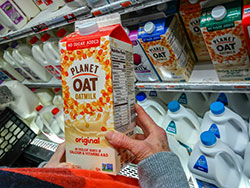As Consumers Get More Involved With Plant-Based Food and Beverage Products, They Will Increasingly Want to Know More About How They’re Made and What’s Inside

Underscoring the power of the plant-based trend, the appearance of Burger King’s plant-based Impossible Whopper and the increasing variety of plant-based and alternative protein options available on restaurant menus and in retail dairy and meat cases highlight the notion that such products are no longer a niche lifestyle choice but a prominent feature of mainstream food culture.
Demand for plant-based foods and beverages is no longer a fringe trend.
Our Food + Technology 2019: From Plant-based to Lab-grown report finds that over half of consumers (51%) had purchased plant-based milk, dairy or meat alternatives in the past three months, saying they’re purchasing such products along the lines of health and wellness, sustainability and a desire for culinary variety in their diets. And these are not “vegetarians.”
Less than half of plant-based purchasers today (41%) think of themselves as people who are limiting meat, and one in five actually describes themselves as carnivores. Furthering Hartman Group insights into the complexity behind plant-based buyers’ diets, only 12% of plant-based purchasers describe themselves as vegetarians, while 41% of them describe their eating styles as “omnivore.”
While a diversity of consumers and eating approaches is driving demand for plant-based products, a potential elephant in the room is the rather sticky conundrum of plant-based foods and beverages offering on one hand a halo of sustainability and wellness (stemming from the positive connections many consumers make between plants and health) and on the other hand the rather common trait of such products to feature extensive signs of processing, both in terms of production and on ingredient labels.
According to Hartman Group CEO Laurie Demeritt in an interview with foodnavigator-usa.com, while many plant-based products are new to consumers (who are more than willing to experiment within alternative protein categories), expect consumers to ask more questions as they learn more about plant-based products.
“Right now, among even non-users, the biggest barriers to adoption of plant-based products remain cost and negative taste perception, so if we can get over that, the market potential is significant. … That said, the highly processed nature of some plant-based products runs counter to the trend towards simpler ingredients, cleaner labels, and traditional processing methods, while the argument that they are by definition healthier than their animal-based counterparts is not a slam dunk. We know that consumers are looking for more real food that’s fresher and less processed, and you could say that everything that’s happening in the (food) technology space is going dramatically in the other direction. There’s a belief that plant-based is healthier, but as the category matures, those opinions could change. There’s a huge rush of enthusiasm now, but I think there’s still a question mark over how many of these products will be adopted long term into consumers’ diets.”
Echoing these sentiments in a recent Hartman Group interview, Adnan Duranni, CEO and Founder of ethnic foods brand Saffron Road Foods, said:
“Just like the Atkins craze a decade ago, which soared and then crashed, I think the “plant-based” gold rush may result in this sector getting ambushed and over-SKU’d by the new players, the retailers and the big CPGs. Many Silicon Valley investors and CPGs are exuberantly rushing into this category without being more mindful or valuing the fact that both vegetarians and NOSH (Natural, Organic, Sustainable & Healthy) consumers will eventually “out” some of these recent players touting vegetarian “meat substitute” options, which aren’t really 100% natural nor free from synthetic or artificial ingredients. … We have deliberately stayed away from protein isolates in our snacks lines and vegetarian entrees, even though using them would enable us to exponentially boost our protein callouts and for sure make the cost of our products a lot cheaper for us to make.”
Looking Ahead in 2020
Plant-based and alternative proteins are growing fast and are having a moment in the limelight. However, giddiness over their growth has been suffused with tension. Many of these products rely heavily on innovative manufacturing, R&D and manipulation of otherwise unexciting ingredients like soy and wheat — the sorts of innovation and processing that consumers often say they want less of, not more of, in their diets. From a high-altitude perspective, technologically innovative foods (particularly meat and dairy alternatives) bring together two long-standing cultural narratives into uncomfortable juxtaposition. On the one hand, consumers want to return to older, simpler ways of making food — a return to Eden. On the other hand, they believe that the forward march of technological progress is ultimately a good thing.
Food + Technology 2019: From Plant-based to Lab-grown finds that consuming plant-based alternatives to dairy and meat is becoming part of a mainstream narrative of what it means to “eat better.” And yet when consumers think of contemporary plant-based options, science and technology are not explicitly front of mind, though some do acknowledge a perception of these products as being “processed.” Those more engaged with health and wellness tend to engage in more scrutinizing of ingredient lists and differentiating between levels of processing within plant-based categories. They prefer shorter, simpler ingredient lists. At the same time, though, they accept compromises in their “ideal” plant-based products for the sake of the convenience they provide. Innovators in food science and technology must consider how to position their products in terms of the dominant narratives of what “positive progress” looks like in food culture today, which centers on a combination of reconnecting to a natural past and excitement for the future. Meat and dairy alternatives cover a broad spectrum of production techniques, ranging from plant-based to lab-grown. Understanding how these categories fit into these frameworks of understanding will be crucial to understanding their trajectory and the trajectory of the American diet and food culture as a whole.
